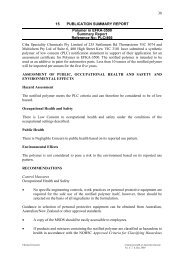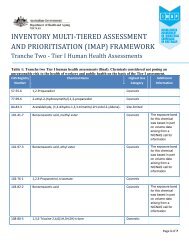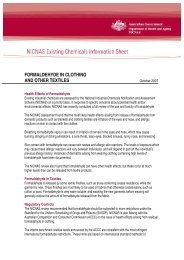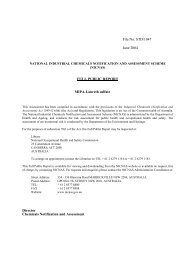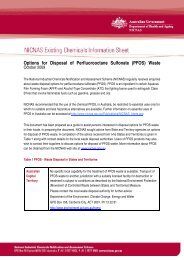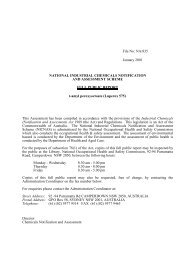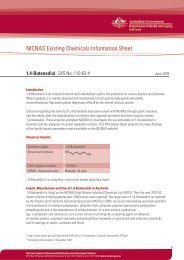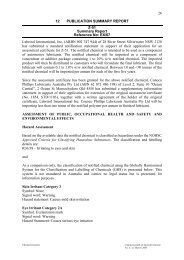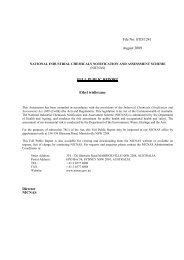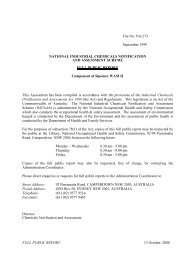GULFTENE C16-18 ISOMERISED OLEFINS - NICNAS
GULFTENE C16-18 ISOMERISED OLEFINS - NICNAS
GULFTENE C16-18 ISOMERISED OLEFINS - NICNAS
You also want an ePaper? Increase the reach of your titles
YUMPU automatically turns print PDFs into web optimized ePapers that Google loves.
The results for a modified Sturm test indicated 48 to 55% degradation after 28 days<br />
incubation with sewage sludge bacteria. The full study was not provided.<br />
8.2.1.b Aerobic Conditions – Marine Studies<br />
The degradation (mineralisation) of chemicals in the marine environment has not been<br />
researched as extensively as has degradation in freshwater environments. However, the<br />
notifier submitted reports for three biodegradation tests conducted with seawater.<br />
Test Substance: <strong>C16</strong>-C<strong>18</strong> isomerised olefins<br />
The first report (Environment & Resource Technology Ltd 1995) detailed the conduct and<br />
results of a test conducted according to the protocols of OECD Test Guideline 306, which is a<br />
variation of the closed bottle biodegradation test (OECD TG 301 D). The test was conducted<br />
in naturally aerated seawater at 20°C, which had been fortified with minerals essential for<br />
bacterial growth over a 28 day period. The decrease in dissolved oxygen levels was<br />
monitored periodically (0, 5, 14 and 28 days), and indicated around 72% degradation over the<br />
28 day test period. The soluble reference compound – sodium benzoate – exhibited 89.2%<br />
biodegradation after 28 days under the same test conditions. It was also noted that there was<br />
no apparent inhibition of bacterial activity resulting from exposure of the bacteria to the new<br />
material. Thus, the degree to which the soluble reference substance (sodium benzoate) was<br />
degraded was similar in media containing the new olefin compound, and in media containing<br />
none.<br />
A second test performed by the same laboratory (Environment & Resource Technology Ltd<br />
1999) using a different sample of material, but otherwise using the same test methodology<br />
(OECD TG 306) indicated 36% biodegradation over the 28 day test period. In this test,<br />
sodium benzoate was again used as the reference material and had degraded by 68%. A<br />
second part of this report gave the results of a marine ISO BODIS test for aerobic<br />
biodegradation. The methodology of this test is very similar to that of OECD TG 306, except<br />
that the closed sample bottles contain 33.3% air (by volume), and are agitated throughout the<br />
test period in order to better simulate real marine conditions. Also, after each sample is taken<br />
(in this case at 7, 14, 21 and 28 days) the samples are aerated to re-establish oxygen<br />
saturation. The result of this test indicated 48% biodegradation of the <strong>C16</strong>-<strong>18</strong> olefin after 28<br />
days, while the reference compound (sodium benzoate) had degraded by 84%. The higher<br />
degree of degradation in the marine BODIS test is presumably due to the higher availability<br />
of oxygen.<br />
The significant difference between the results obtained from the two OECD TG 306 tests,<br />
namely, 72% degradation in one test as opposed to 36% in the other, could reflect differences<br />
in the bacterial populations of the sea waters used as test media. Alternatively, differences in<br />
the degree and position of branching in the olefin chains of the samples used in each test or<br />
other factors could be responsible.<br />
Overall, the results of these tests indicate that the new compound is at least potentially<br />
biodegradable under aerobic conditions. However, one of the reports (Environment &<br />
Resource Technology Ltd 1995) noted that the controlled conditions of a laboratory<br />
environment may not reflect those of the “real world”, and that the actual rate of degradation<br />
for released material may be significantly slower. In particular it was observed that<br />
FULL PUBLIC REPORT 26 April 2000<br />
NA/713 Page 13 of 100



